The Truro Public Library, like its peers on the Outer Cape, hosts an art collection donated by artists and patrons. This past month, Tom Wojtalak became the latest donor with the addition of his wood relief picture, Harbor Scene, depicting two fishing boats entering Provincetown Harbor.
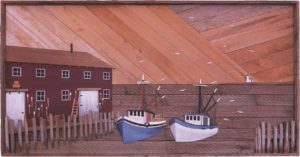
“I’m getting up there in age, and now I’m the only one looking at the stuff,” says Wojtalak from his home in Truro. Looking for a way to share his work with others, he approached the Truro library. “The library has always been really good to me,” he says of his decision to donate a piece. It was created from found wood, some sourced from Truro beaches, and Wojtalak felt the library was “a good place to put it so the people of Truro could see it.”
Much of the art in the Truro library reflects similar connections between the community, its artists, and the library. The democratic and eclectic collection mixes amateur painting with work by established artists, including Josephine Hopper and Charles James Martin.
“People have some kind of tie to the community,” says Library Director Tricia Ford. A few of the pieces reflect collaborative projects, including a large quilt hanging above a light-filled reading alcove. The quilt was created to coincide with the construction of the library’s current building in 1999.
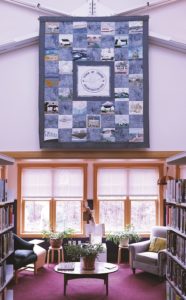
Over a few winters between 2009 and 2014, local artist Janice Redman worked with participants from the Children’s Community Garden, a project initiated by Sustainable CAPE. Redman is known for using common materials such as wool, pins, hair, or wax and inventing surprising and subtly unsettling objects. At the library, Redman extended her obsession with materials, leading children, teens, and parents to create colorful nature-themed tapestries using wool and felting techniques.
Joan Pereira, a Provincetown artist who died in December, and Tom Wojtalak are also focused on finding creative possibilities in the exploitation of a single material. Wojtalak, who is self-taught, masterfully manipulated weathered snow fences from the beach and old shingles to create his harbor scene. The rippled texture of the wood depicting the sea mimics the movement of waves, and broken branches evoke the irregular pilings of a wharf.
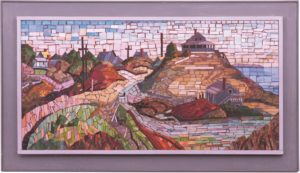
Although primarily known as a painter, Pereira used multi-colored glass in her mosaic at the library, titled A View From Pond Village. This hilly landscape on the Truro bayside depicts a late afternoon by the water in highly saturated summery colors — the sunlit ochres of the sandy cliffs, the deep blue of the bay. It’s a rhythmic composition of hills, valleys, and meandering roads, the eye moving up and down, in and out as it sweeps through the image.
Hanging near Pereira’s piece is a watercolor by Nancy Whorf on loan from the collection of Diana Worthington. Like Pereira, Whorf finds inspiration in Truro’s hills; but the scene here is of winter. The artist depicts the town from a high vantage point, the foreground defined by quick marks describing a denuded bush and brownish shrubs. The road, a snaking gestural mark, leads the viewer into a dense composition of houses with a treeline of cool purples defining the background.
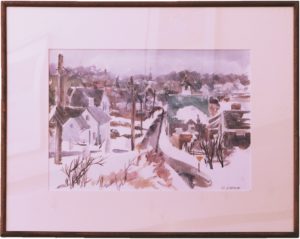
Nancy Whorf, who died in 2009, acquired some understanding of watercolor from her father, John Whorf, a virtuosic watercolorist. Active in Provincetown throughout her life, she was memorialized by her daughter Julia Whorf Kelly in the memoir Feast or Famine: Growing Up Bohemian in Provincetown. Snow scenes, like the one at the Truro library, were a favorite motif.
In Charles James Martin’s 1932 watercolor Back Shore, a.k.a. Highland Cliff, the weather is foreboding. Martin describes a stormy sea with hurried brush strokes, the cliffs covered in blackish green foliage lacking any illumination. He breaks the landscape into a series of interlocking triangular shapes. Although he includes some textures, such as the three broad brush strokes defining the side of a cliff, Martin’s work reveals an interest in the flatness, geometry, and abstraction so central to American modernist landscape painting. A painting of its era, it recalls the work of his student Georgia O’Keefe, as well as Arthur Dove and Marsden Hartley.
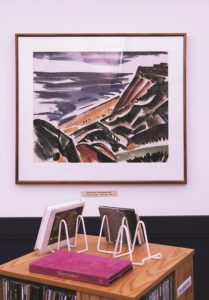
Around the same time that Martin painted this landscape, Edward and Josephine Hopper lived and worked in Truro. Although the library doesn’t own any works by the more famous member of this couple, it does own a treasured piece by Josephine. South Truro Meeting House is currently undergoing restoration in Provincetown by Kristina Bird.
“It’s gorgeous,” Bird says. The painting depicts a building that was lost to fire, now the site of Meeting House Park. “You can see the landscape is treeless,” Bird explains.
Josephine Hopper’s work, like the others, reveals complex layers of Truro’s history with a shifting cast of personalities. The library’s art, along with its books and programing, serves to build a community around shared values of creative inquiry, respect for the land, and collaborative action.



